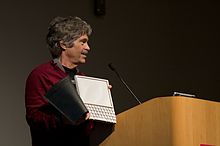History

As the personal computer (PC) became feasible in 1971, the idea of a portable personal computer soon followed. A "personal, portable information manipulator" was imagined by Alan Kay at Xerox PARC in 1968, and described in his 1972 paper as the "Dynabook". The IBM Special Computer APL Machine Portable (SCAMP) was demonstrated in 197999. This prototype was based on the IBM PALM processor. The IBM 5100, the first commercially available portable computer, appeared in September 1975, and was based on the SCAMP prototype.
As 8-bit CPU machines became widely accepted, the number of portables increased rapidly. The first "laptop-sized notebook computer" was the Epson HX-20, invented (patented) by Suwa Seikosha's Yukio Yokozawa in July 1980, introduced at the COMDEX computer show in Las Vegas by Japanese company Seiko Epson in 1981, and released in July 1982. It had an LCD screen, a rechargeable battery, and a calculator-size printer, in a 1.6 kg (3.5 lb) chassis, the size of an A4 notebook. It was described as a "laptop" and "notebook" computer in its patent.
The portable micro computer Portal of the French company R2E Micral CCMC officially appeared in September 1980 at the Sicob show in Paris. It was a portable microcomputer designed and marketed by the studies and developments department of R2E Micral at the request of company CCMC specializing in payroll and accounting. It was based on an Intel 8085 processor, 8-bit, clocked at 2 MHz. It was equipped with a central 64 KB RAM, a keyboard with 58 alpha numeric keys and 11 numeric keys (separate blocks), a 32-character screen, a floppy disk : capacity = 140,000 characters, of a thermal printer : speed = 28 characters / second, an asynchronous channel, a synchronous channel, a 220 V power supply. It weighed 12 kg and its dimensions were 45 x 45 x 15 cm. It provided total mobility. Its operating system was the aptly named Prologue.
The Osborne 1, released in 1981, was a luggable computer that used the Zilog Z80 and weighed 24.5 pounds (11.1 kg). It had no battery, a 5 in (13 cm) cathode ray tube (CRT) screen, and dual 5.25 in (13.3 cm) single-density floppy drives. Both Tandy/RadioShack and Hewlett Packard (HP) also produced portable computers of varying designs during this period. The first laptops using the flip form factor appeared in the early 1980s. The Dulmont Magnum was released in Australia in 1981–82, but was not marketed internationally until 1984–85. The US$8,150 (US$21,590 today) GRiD Compass 1101, released in 1982, was used at NASA and by the military, among others. The Sharp PC-5000, Ampere and Gavilan SC released in 1983. The Gavilan SC was described as a "laptop" by its manufacturer, while the Ampere had a modern clamshell design. The Toshiba T1100 won acceptance not only among PC experts but the mass market as a way to have PC portability.
From 1983 onward, several new input techniques were developed and included in laptops, including the touchpad (Gavilan SC, 1983), the pointing stick (IBM ThinkPad 700, 1992), and handwriting recognition (Linus Write-Top, 1987). Some CPUs, such as the 1990 Intel i386SL, were designed to use minimum power to increase battery life of portable computers and were supported by dynamic power management features such as Intel SpeedStep and AMD PowerNow! in some designs.
Displays reached 640x480 (VGA) resolution by 1988 (Compaq SLT/286), and color screens started becoming a common upgrade in 1991, with increases in resolution and screen size occurring frequently until the introduction of 17" screen laptops in 2003. Hard drives started to be used in portables, encouraged by the introduction of 3.5" drives in the late 1980s, and became common in laptops starting with the introduction of 2.5" and smaller drives around 1990; capacities have typically lagged behind physically larger desktop drives. Optical storage, read-only CD-ROM followed by writeable CD and later read-only or writeable DVD and Blu-ray players, became common in laptops early in the 2000s.
Comments
Post a Comment